In the sun-drenched landscapes of the Southwestern United States, there’s a creature that many folks might secretly wish they could enlist as their ally: the Texas horned lizard. Known for their striking appearance and the legendary story of Ol’ Rip, these spiky reptiles possess a skill that could make them incredibly handy to have around in the event of an ant infestation. One of the hallmarks of this intriguing species is its diet which consists almost exclusively of ants! Let’s burrow into the fascinating world of Texas horned lizards. We’ll learn about their lifespan, size, habitat, and more as we uncover the attributes that make Texas horned lizards unique.
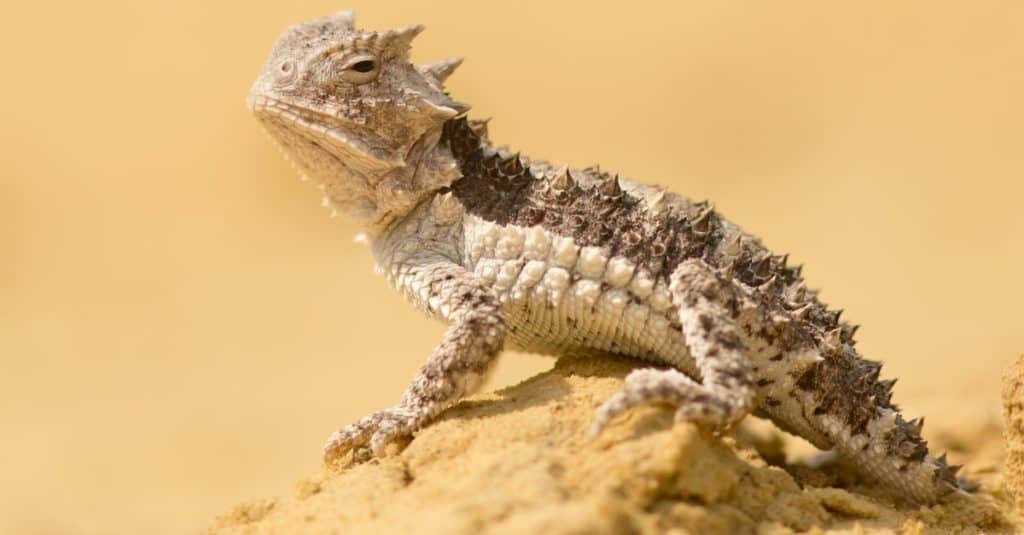
One of the hallmarks of the Texas horned lizard is its diet, which consists almost exclusively of ants!
©Milan Zygmunt/Shutterstock.com
Texas Horned Lizard: Appearance
The Texas horned lizard (Phrynosoma cornutum), is a species of lizard native to the Southwestern United States and Northern Mexico. It is also referred to as the horned toad, horned frog, or horny toad. However, it is not a true toad or frog but a lizard. Texas horned lizards are distinctive for their flattened, oval-shaped bodies covered in spiky, horn-like scales, which give them their name. These scales provide them with some protection against predators. They have a pointed snout and short legs. Their color palette is a mix of gray to brown, helping them blend in with their desert surroundings. Texas horned lizards vary in size, but on average, they measure from 2.5 to 5 inches (6 to 15 cm) in length from the tip of their snout to the base of their tail. Females of the species are generally larger than males.
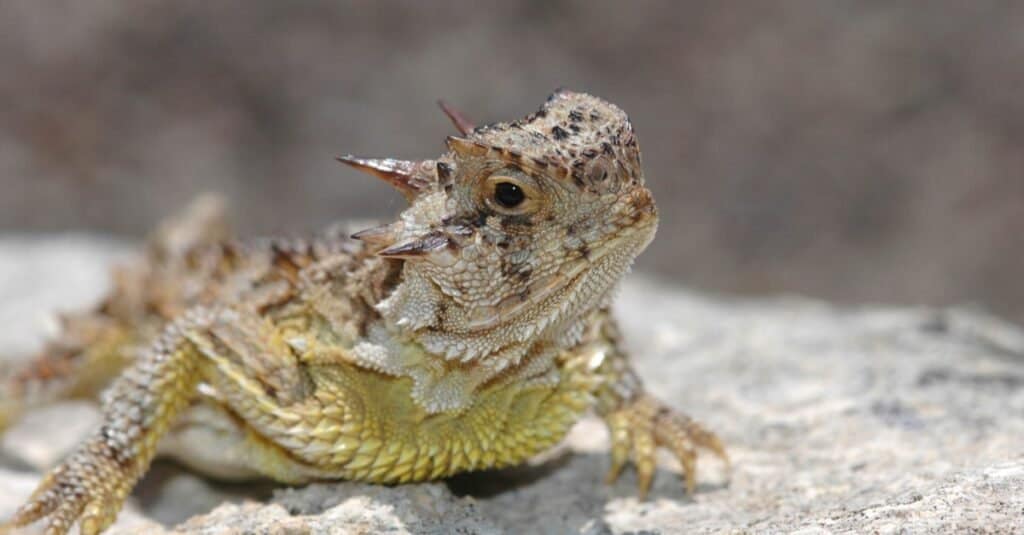
A Texas horned lizard resting on a rock. Its horny appearance and coloration help it to blend in with sparse vegetation.
©iStock.com/Shoemcfly
Behavior
Texas horned lizards are generally docile and non-aggressive toward humans. They are wild animals and should be observed from a respectful distance in their natural habitat. Conservation efforts are in place to protect and preserve these unique reptiles due to their specialized behavior and their importance in their ecosystems.
List of General Characteristic Behaviors Of Texas Horned Lizards
- Slow-Moving: Texas horned lizards are generally slow-moving reptiles. They move at a leisurely pace when foraging for food or sunbathing.
- Basking: Like many reptiles, they are ectothermic, meaning they rely on external sources of heat to regulate their body temperature. They often bask in the sun to warm up their bodies.
- Burrowing: Texas horned lizards are capable of digging shallow burrows in the soil. They may use these burrows for shelter from extreme temperatures and predators.
- Defense: These fascinating creatures are known for their ability to shoot blood from their eyes (eyelids). They use this ability as a defense mechanism when threatened, which can be an effective deterrent against some predators. This behavior is often used as a last resort.
- Camouflage: Their spiky, horn-like scales and coloration allow them to blend into their environment, protecting against potential threats.
- Territorial: Texas horned lizards can be territorial and may defend their home range from other horned lizards, especially during breeding season.
- Solitary: They are primarily solitary animals and do not form social groups. They usually interact with other horned lizards during mating and territorial disputes.
- Breeding Rituals: During the breeding season, males engage in courtship displays to attract females. These displays may involve head-bobbing, puffing up their bodies, and other visual cues.
- Nocturnal Activity: While they are active during the day, they may also be active at night, especially in warmer weather, to avoid extreme daytime temperatures.
- Seasonal Activity: Texas horned lizards may go into a period of reduced activity during extreme weather conditions.
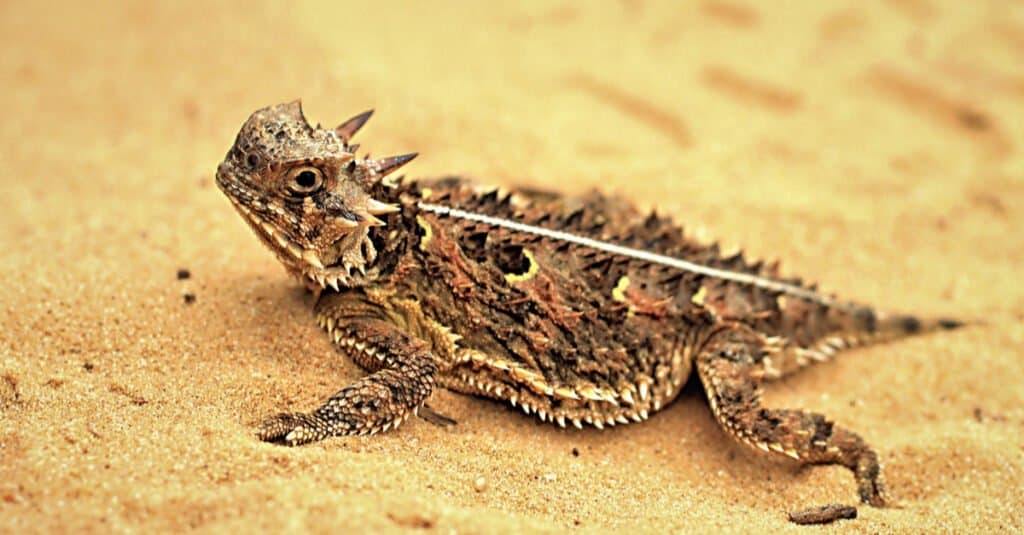
These fascinating creatures are known for their ability to shoot blood from their eyelids!
©Seth LaGrange/Shutterstock.com
Texas Horned Lizard: Diet
One of the notable features of the Texas horned lizard is its diet, which consists mainly of ants (Formicidae). While ants are their primary food source, they may also consume other small arthropods and insects when ants are not readily available. Texas horned lizards are particularly adapted to feed on ants. They use their long, sticky tongue to capture and consume individual ants. Texas horned lizards are known to eat a variety of ant species, and their diet often includes harvester ants, red ants, and black ants. They may also consume ant larvae and pupae, as these are softer and easier to eat than adult ants.
While ants make up the majority of their diet, Texas horned lizards may consume other small insects and arthropods when ants are scarce or less accessible. These include termites, beetles, and grasshoppers. Texas horned lizards obtain most of their water from the body fluids of the ants they consume. They have adaptations to minimize water loss, and they do not typically drink water from other sources. Their hunting strategy often involves sitting still and waiting for ants to come close, then using their quick tongue to catch them. This specialized diet also influences their habitat preferences, as they need to live in areas where ants are abundant.
Texas Horned Lizard: Habitat
The Texas horned lizard is native to the Southwestern United States and parts of Mexico. Its distribution includes arid and semi-arid regions. These hardy reptiles are found in Texas, New Mexico, Oklahoma, Missouri, Arkansas, and Northern Mexico, including Coahuila, Chihuahua, Tamaulipas, and Nuevo León.
The distribution of Texas horned lizards has been affected by habitat loss, fragmentation, and declines in population numbers in some areas. In some regions, horned lizards are considered threatened or endangered. Conservation efforts are in place to help protect and restore their habitats and populations in their native range. In Texas, legal protections are in place to safeguard their populations. It’s illegal to catch, keep, sell, trade, or breed Texas horned lizards in Texas without the proper certifications. Breeding programs, like the one at the San Antonio Zoo, are finding success releasing horned lizards into the wild.
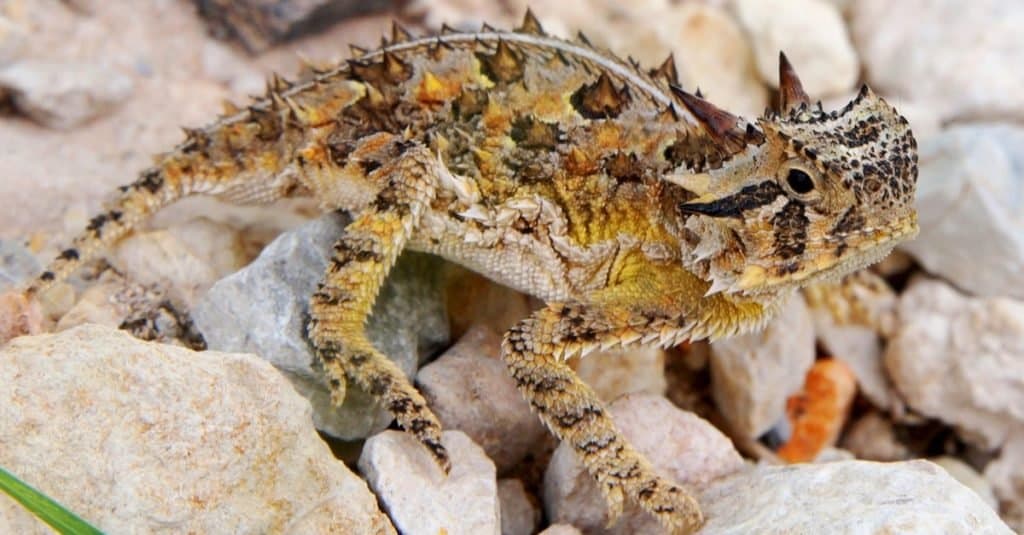
It’s illegal to catch, keep, sell, trade, or breed Texas horned lizards in Texas without the proper certifications.
©Matt Jeppson/Shutterstock.com
Texas Horned Lizard: Predators and Threats
Texas horned lizards face several predators and threats in their natural habitat. Some of the primary predators and threats include:
- Birds of Prey: Raptors such as hawks and owls are known to prey on Texas horned lizards. Their elevated position and keen eyesight make them effective hunters of these lizards.
- Snakes: Some snake species, including rattlesnakes and coachwhips, prey on Texas horned lizards.
- Mammals: Various mammals, such as coyotes, foxes, and skunks, eat Texas horned lizards if they come across them.
- Amphibians: Some amphibians, such as bullfrogs and larger toads, might see smaller horned lizards as potential prey.
- Humans: Humans are the drivers of habitat destruction and urban development.
- Habitat Loss: The destruction and alteration of their natural habitat due to urbanization, agriculture, and development have led to habitat loss for Texas horned lizards. Loss of suitable foraging and breeding grounds are major threats to their survival.
- Road Mortality: Texas horned lizards are often killed by vehicles when they venture onto roads, as they are slow-moving and may bask on warm road surfaces.
- Collection for the Pet Trade: In the past, these lizards were collected from the wild for the pet trade. However, this practice is now illegal due to their protected status.
Conservation efforts are in place to address these threats and protect Texas horned lizards in their natural habitats. Efforts include habitat preservation, research, and education about the importance of conserving these unique reptiles. Legal protections are in place in many areas to prevent their collection and sale as pets.
Lifecycle
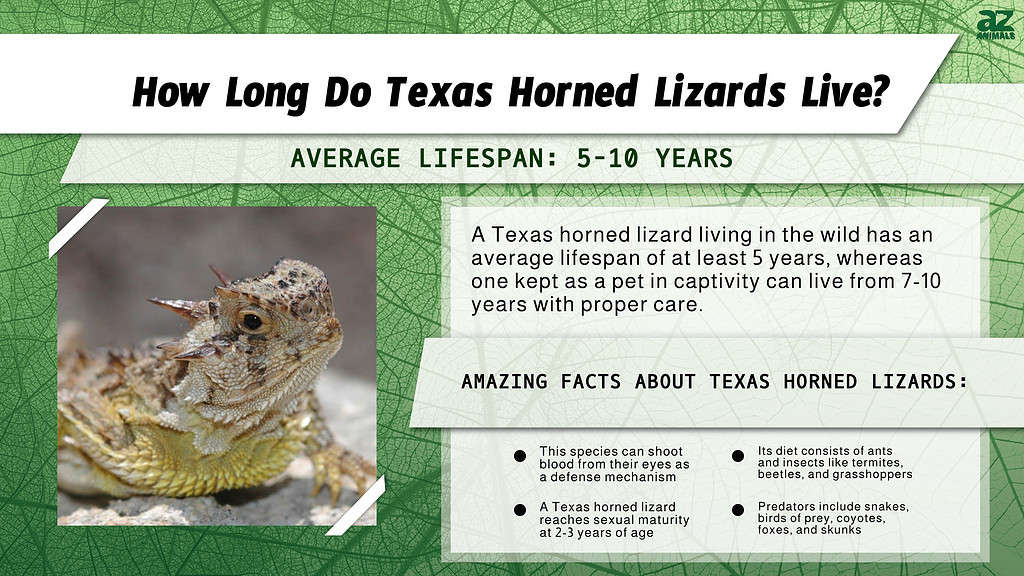
The lifecycle of the Texas horned lizard begins with the female Texas horned lizard laying a clutch of eggs. These eggs are typically buried 6 to 8 inches (15-20 cm) deep in sandy or loose soil to provide protection and maintain an appropriate temperature for incubation. The number of eggs in a clutch can vary but generally ranges from 13 to 45 eggs. The eggs are left to incubate in the soil for 5 to 9 weeks. The exact duration of incubation depends on environmental conditions, particularly temperature. Warmer temperatures can result in shorter incubation times. After the incubation period, the eggs hatch, and tiny juvenile horned lizards emerge from the ground. These juveniles, a tad shy of an inch (2.5 cm) at birth, are miniature versions of the adults but lack fully developed horns and may have a slightly lighter complexion.
During their juvenile stage, young Texas horned lizards are vulnerable to predation and environmental stressors. They continue to grow and develop. Their horns gradually become more prominent over time. As the juveniles grow, they feed primarily on ants and other small insects. Their diet and habitat preferences become more similar to those of adult horned lizards as they mature. Texas horned lizards reach sexual maturity between 2-3 years of age, depending on various factors such as food availability and environmental conditions. Once mature, they engage in breeding activities. Breeding occurs in the spring or early summer. Mating involves courtship displays and breeding between male and female horned lizards. The female then lays her eggs, starting the lifecycle anew.
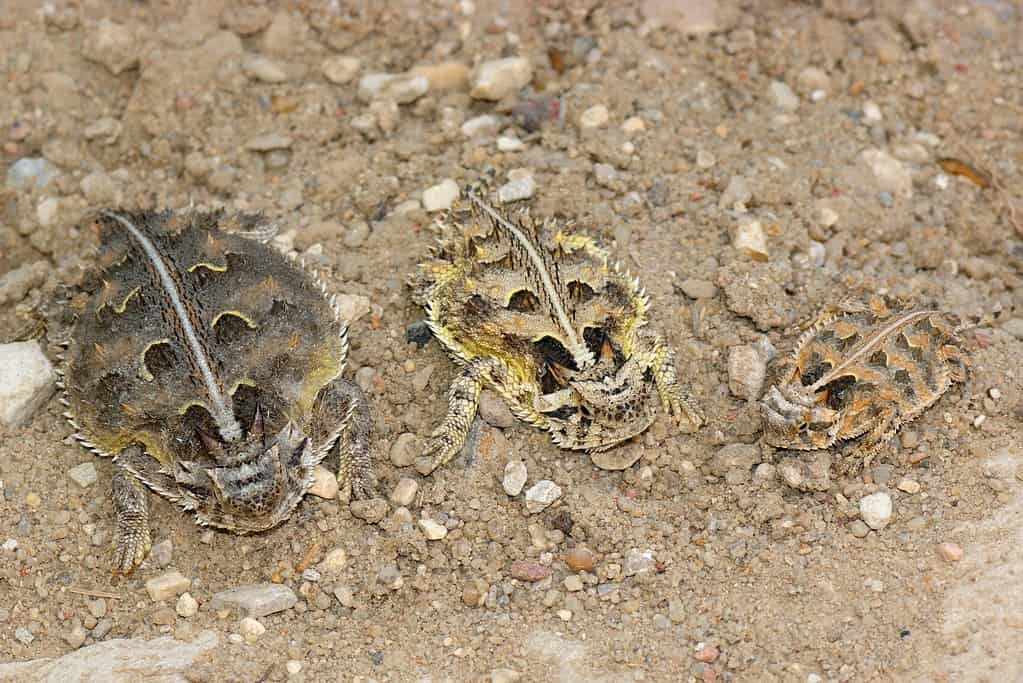
Juvenile Texas horned lizards are miniature versions of the adults but lack fully developed horns and may have a slightly lighter complexion.
©Matt Jeppson/Shutterstock.com
Texas Horned Lizard: The Tale of Ol’ Rip
Ol’ Rip was a famous Texas horned lizard that gained widespread notoriety due to an unusual and somewhat unbelievable tale. According to the story, in 1897, the citizens of Eastland, Texas buried a time capsule on the grounds of the Eastland County Courthouse. This time capsule included various items representative of the time, including newspapers and other artifacts. However, what captured the most attention was the inclusion of a horned lizard, which the locals named Ol’ Rip.
Ol’ Rip was placed in the time capsule on July 20, 1897. It was thought that Texas horned lizards were capable of hibernating for long periods. In 1928, after 31 years of being entombed, the time capsule was opened. To everyone’s astonishment, Ol’ Rip was found alive and well, or so the story goes. The news of Ol’ Rip’s survival created a sensation, and he became a celebrity overnight.
Truth or Fiction?
Many experts questioned the authenticity of the story, suggesting that the lizard found in 1928 might not have been the same one placed in the time capsule. Horned lizards are known for their hardiness and can go into a state of hibernation when conditions are adverse, which might have allowed the lizard to survive for an extended period. Despite the controversy, Ol’ Rip remains a beloved part of Texas folklore and an enduring symbol of the state’s spirit. Whether the story is entirely true or not, it continues to be a source of pride and amusement for Texans. The Texas horned lizard is the official Texas State Reptile.
The photo featured at the top of this post is © Seth LaGrange/Shutterstock.com
Thank you for reading! Have some feedback for us? Contact the AZ Animals editorial team.






